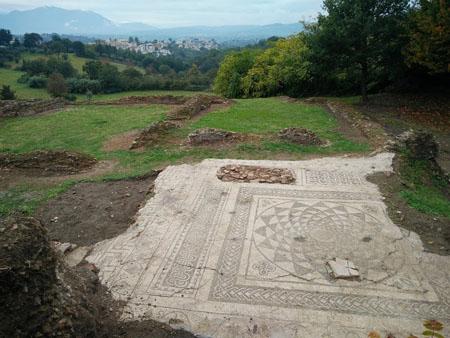2017 season
Work undertaken in 2017 at the site.

In order to better understand the built environment of the city and its urban layout, four areas of excavation were opened in 2017 – one in the area of a monumental structure previously assumed to be a nymhaeum (Area A); a second in the largest excavated structure in the city, the baths (Area B); a third in a central area which geophysics suggested was residential zone (Area C); and, a fourth in what appears to be the public core of the city, containing a macellum (Area D).
Results from Area A show that this building is in fact the city’s theatre (the first to be excavated in Hirpinia), which was built in the 1st c. AD and heavily spoliated from the 4th c. AD onwards. In Area B, a series of 4th-c. AD alterations to the bathing complex were exposed: a new mosaic, which has been conserved, and a room with a marble-paved floor; this later room contained primary volcanic deposits associated with the AD 472 eruption of Vesuvius. In Area C, a collapsed structure was excavated, the layout and date of which suggest a connection with the well-known early 4th c. AD earthquake that hit the city. In Area D, geophysics and excavation explored not just the macellum but also identified an adjacent open paved area, almost certainly the city’s forum.
Our intensive GPR survey was continued in 2017 to cover a further three hectares of the site. These revealed the rest of the forum area, a series of public buildings facing on to the western side of this space, and domestic structures organised into regular city blocks beyond this. GPR transects across much of the rest of the city identified several areas of rich archaeological remains, which will be investigated further in future seasons.

